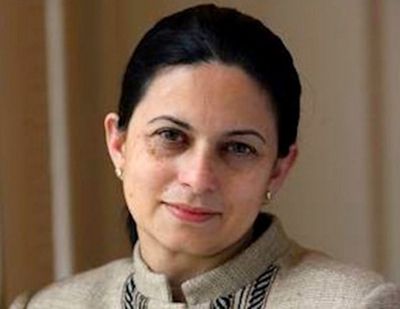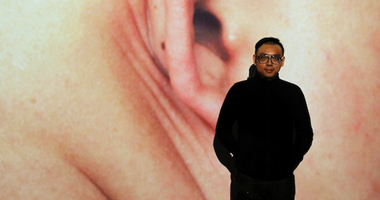Savita Apte on South Asian art
Savita Apte. Photo: Alex McGuire.

Savita Apte. Photo: Alex McGuire.
Savita Apte, well respected art historian and formidable supporter of the arts, talks to Anna Dickie about how a microbiologist came to be an art historian and reflects on the definition of South Asia and the Singapore art scene.
Specialising in modern and contemporary South Asian art, Savita Apte began her career at Sotheby's where she was a consultant expert from 1995 to 2001. While at Sotheby's, Apte was instrumental in founding the Sotheby's Prize for Contemporary Indian Art.
Currently she acts as Director of Art Dubai, Chair of The Abraaj Group Art Prize, Associate of Serpentine Gallery for Indian Highway, and sits on the advisory board of the Sovereign Art Fund and Para/Site. Apte is also a regular lecturer at the School of Oriental and Asian Studies, University of London and the Sotheby's Institute, and recently submitted her Ph.D doctorial thesis.
One of Apte's current projects involves Platform, an independent non-profit organization, which she and two other founding directors, Shareen Khattar and Christine Pillsbury, set up in Singapore. Platform works as a conduit between a burgeoning collector scene and promising artists in the region.
ADHow did you initially come to be interested in art?
SAIt's a long story! My initial degrees were in the sciences. I'm a microbiologist and immunologist and never in my wildest dreams imagined that I would end up not being a scientist. However, I always fancied myself as being someone who could produce creatively. I did my A levels starting off in art but, being a science student, I very quickly realised I didn't have enough studio time. I was then asked if I would like to do some art history instead.
I had the best teacher in the world and he really opened art history up to me. In particular, he taught me to use my eyes. He said you look through the microscope at things and you analyse them, so use the same techniques when you are looking at a painting. It's easy to browse past works you think you know—you've seen them on magazine covers, chocolate boxes—and you think therefore you know them. If you stop and look, it is amazing what you discover. Although art history stayed on the back burner all through university, it then somehow matured from a hobby into a way of life.
ADYou recently submitted your doctoral thesis. Tell me about your thesis?
SAMy thesis charts modernism in India. As all PhDs it has a title that really doesn't communicate very much, but it is called: Unchallenged dichotomies: The Progressive Artists and the Advent of Modernism in India. It's about a tiny period in time, 1947-1949, when this group of six artists came together and in my way of thinking really changed the way Indian art was produced, thought of and written about.
ADWas this an opportunity to dig deeper into the wider topic of South Asia?
SAWhen I was doing my dissertation for my Masters I thought it was very clever to know about something and to try and do it in depth. Doing a thesis for a PhD you end up having to read so much around a topic that in fact your knowledge of literature, film, culture, anthropology and so on begins to develop.
The reading of both works of art as well as cultural production becomes very different. It is much more complex because you are reading structural theory around a topic as well. It isn't until you come out at the other end that you realise you have concentrated on a very small period but you have used numerous tools to look at that small period.
ADHow do you define South Asia for yourself?
SAI define it aesthetically. However, it is defined by outside forces as a geographical region. The reason I define it aesthetically is that until recent political events (and by recent I mean events that have taken place in the last 100 years) this area was very much part of one aesthetic background.
Between countries like Pakistan and India, or Tibet, Nepal and India, or India and Sri Lanka there was free cultural movement. That is not to say that one country dominated the others, but there was very much a common aesthetic theme that ran through these nations. You must remember that until a hundred years ago these countries were considered one region with very permeable borders.
ADYou are now based in Singapore. When did you move to Singapore?
SAI moved to Singapore two years ago. I was in Hong Kong for two years and in London before that for a number of years.
ADHow would you define the Singapore contemporary art scene?
SAI think that like most countries in the region this is an emerging and amazing scene. What I enjoy about Singapore and what I have been wonderfully surprised to discover is the number of galleries that are sprouting up constantly. The government, hand in hand with the arts community, has funded and pushed through initiatives that will reap rewards in the next 5 to 10 years.
The Gillman Barracks is a wonderful initiative that concentrates a group of international and regional galleries in one area. This space has provided people with one place to see lots of galleries in a weekend or a day. A community is created not only of galleries, but their audience, the artists, the gallerists and all the arts management people that work around the art world—those people that are fundamental to an art eco-system. I think it is really nice that the Singapore government feels they are able to encourage this sort of community building.
In London or New York, where there are so many institutions that are easily accessible, artists have been able to go and see what other artists have been doing in the past or are doing now. Institutions such as the Tate, Tate Modern, National Gallery, and the Wallace Collection have allowed artists to touch base with a community without needing to actually physically communicate with it. In any small country, as Singapore is, and in a situation—and this is true of countries across the board in Asia—where artists have grown up without institutions the building of supportive art communities is so important.
ADTell me about the artists coming out of Singapore? Are there many artist led initiatives in Singapore?
SAThere are many amazing artists coming out of Singapore. Ho Tzu Nyen, Song-Ming Ang, Ming Wong, Heman Chong to name some.
There are also a number of artist led initiatives. For example, there was a small group of artists who heard about the renovation of a number of old houses. These were family owned houses. These artists felt they were watching so much history disappear and they wanted to commemorate the fact that these houses were going through this evolution.
So they staged a series of exhibitions and interventions in the houses. This is just one of the artist led things that is happening here in Singapore. 'The Substation', which I am sure you know, is a complete artist led, independent space as well. The level of art and interaction that these initiatives generate is quite tremendous.
They really get the community around them involved. Often that involvement comes in the question of "Is this art and why are you doing it?". They work at convincing people around them that what they are doing is what artists have done forever—simply reflect what is happening to society.
ADI understand that Platform is working with Singapore artists on a number of initiatives. Tell me about Platform and an example of such an initiative?
SAPlatform is an independent not for profit charitable organisation that Shareen Khattar, Christine Pillsbury and myself set up. The purpose of Platform is to bring together a pool of serious art collectors and patrons and introduce them to promising artists in the region. We have also become involved in a number of initiatives with artists, for example we partner with Asia Art Archive for a project that is centered in South East Asia and is based in Singapore.
Ho Tzu Nyen is producing A Dictionary of Critical Terms for South East Asia. There has been a shift of wealth and attention towards Asia and we felt it was time the region started to produce its own terminology rather than having it forced on it by people who have studied about the region from outside the region. I think this a reflection of a maturing of the art world that is taking place in Asia. We are standing up and accepting responsibility for what we are producing: in terms of writing about art and in terms of the way we communicate through exhibitions about art.
ADHow would you describe the collectors coming out of Singapore?
SAI have again been amazed by the calibre of collectors I have met in Singapore—they are both regionally and internationally engaged. They are genuinely interested in art being created both geographically near them and afar.
ADWhat responsibility does a collector have in relation to artworks they add to their collection?
SAA collector has the responsibilities that he or she brings upon him or herself. No one puts any onus of responsibility on the collector, but the collector themselves.
However, you will generally find that a good collector is someone who not only preserves and conserves the art they collect for posterity, but also develops some sort of deep understanding; enough to be able to communicate that passion to other people. I believe the biggest responsibility a collector has is communicating his or her own passion.
ADTell me about your view on the debate of Singapore verse Hong Kong as Asia's art hub?
SAI think this is a very Western perspective that is overlaid on Asia quite unnecessarily. If you go back several centuries you will see that Asia has prided itself on having several centers and hubs. I think the same is going to be true in the future as well. It's a false idea to set up a competition.
Each city, both Hong Kong and Singapore, have so much to offer in so many different ways and they can very well co-exist by doing exactly what they do best. Rather than the world setting up this competition it would be very nice to be able to say that Asia has Singapore and Hong Kong. —[O]











































































































































































